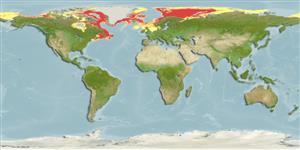Environment: milieu / climate zone / depth range / distribution range
Ecología
marino demersal; rango de profundidad 25 - 1187 m (Ref. 58426). Polar; 84°N - 42°N, 180°W - 180°E
Arctic: Arctic Alaska, Smith Sound, northwest Greenland, Kara Sea, Barents Sea, off Spitsbergen, coast of Norway, Wyville-Thomson Ridge, Iceland, northeast Greenland, and localities off western Greenland.
Tamaño / Peso / Age
Maturity: Lm ? range ? - ? cm
Max length : 44.5 cm SL macho / no sexado; (Ref. 11976)
Benthic; feeds on crustaceans (Ref. 58426). Switches feeding habits with increasing size. Smaller eelpouts eat mainly endobenthic prey, larger individuals feed more on epibenthic prey (Ref. 13532).
Life cycle and mating behavior
Maturities | Reproducción | Spawnings | Egg(s) | Fecundities | Larva
McAllister, D.E., M.E. Anderson and J.G. Hunter, 1981. Deep-water eelpouts, Zoarcidae, from Arctic Canada and Alaska. Can. J. Fish. Aquat. Sci. 38(7):821-839. (Ref. 11976)
IUCN Red List Status (Ref. 130435)
Threat to humans
Harmless
Human uses
Herramientas
Special reports
Download XML
Fuentes de Internet
Estimates based on models
Preferred temperature (Ref.
123201): -0.9 - 4, mean 0.8 °C (based on 1789 cells).
Phylogenetic diversity index (Ref.
82804): PD
50 = 0.5000 [Uniqueness, from 0.5 = low to 2.0 = high].
Bayesian length-weight: a=0.00251 (0.00156 - 0.00403), b=3.21 (3.07 - 3.35), in cm total length, based on LWR estimates for this species & Genus-body shape (Ref.
93245).
Nivel trófico (Ref.
69278): 3.5 ±0.50 se; based on food items.
Resiliencia (Ref.
120179): Muy bajo, población duplicada en un tiempo mínimo superior a 14 años (Preliminary K or Fecundity.).
Fishing Vulnerability (Ref.
59153): Moderate vulnerability (42 of 100).
